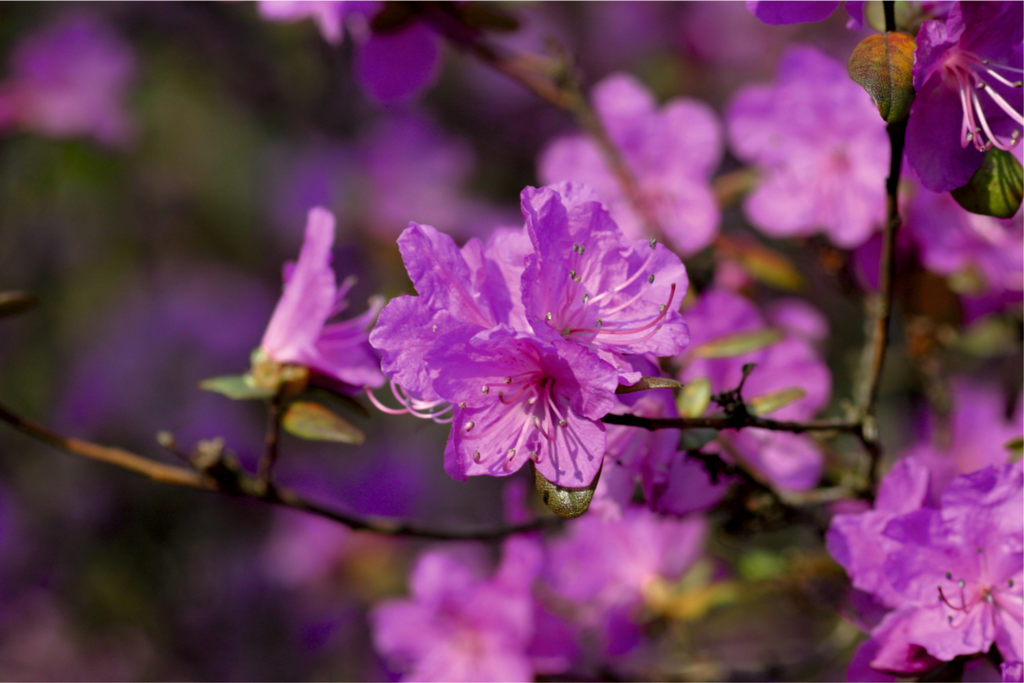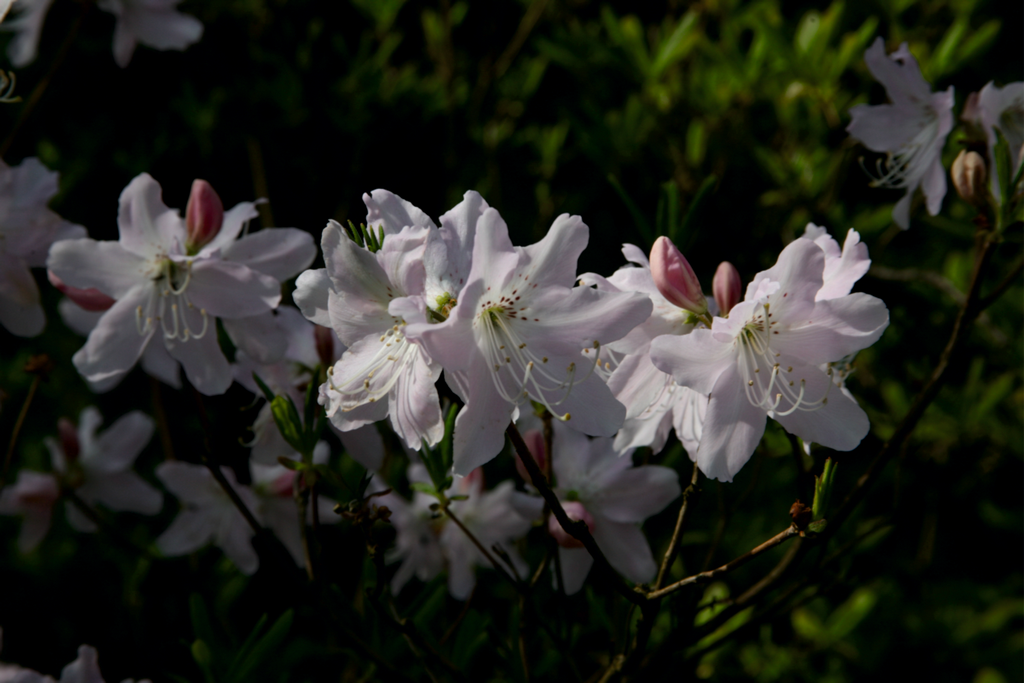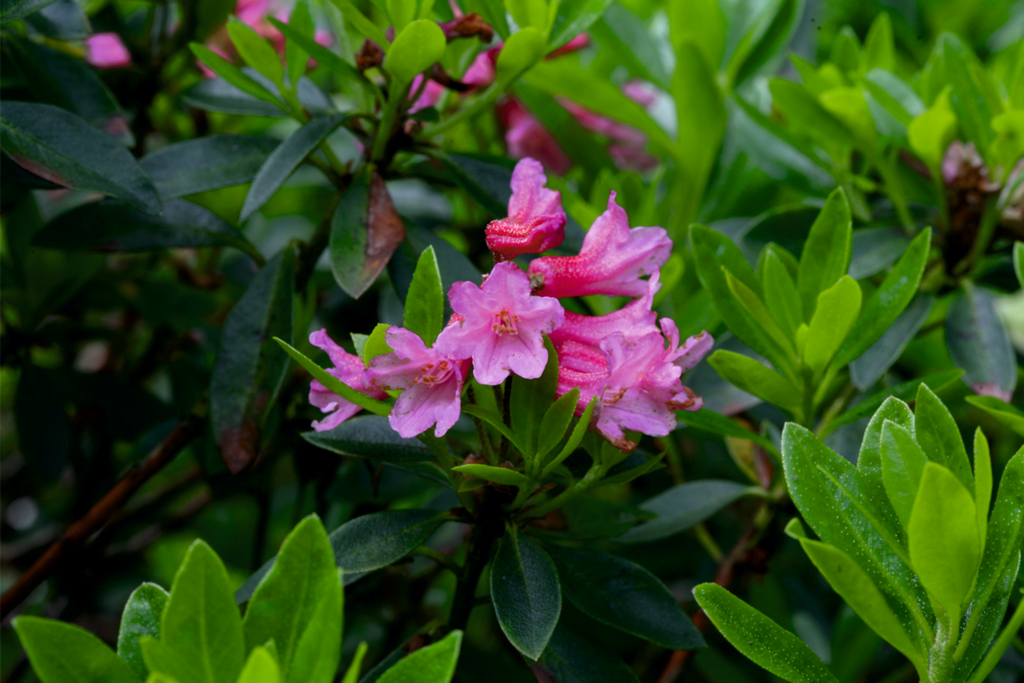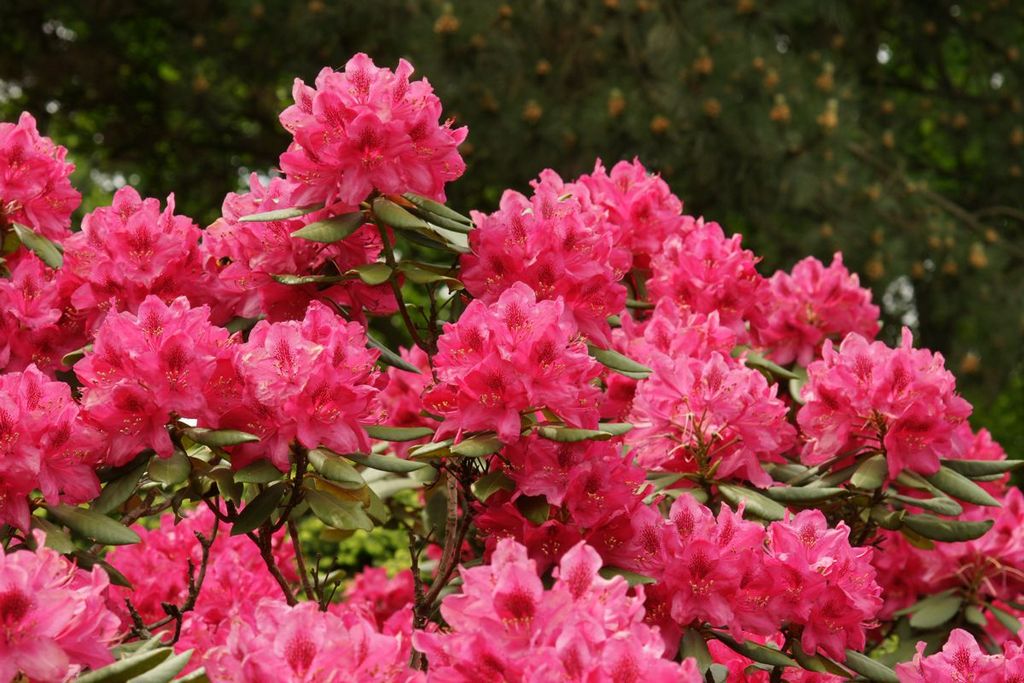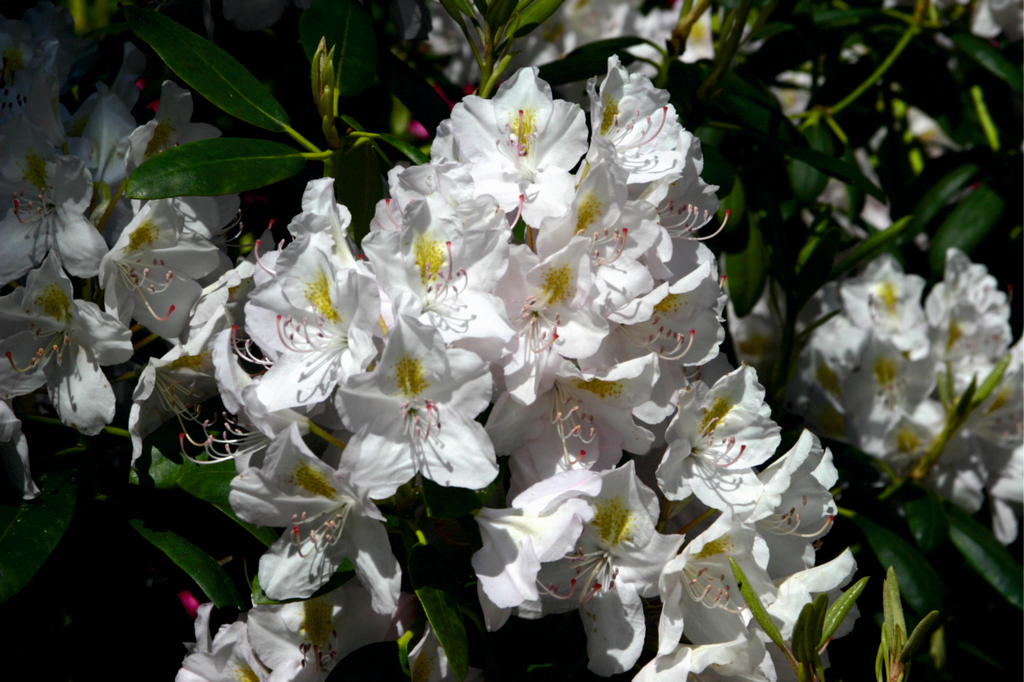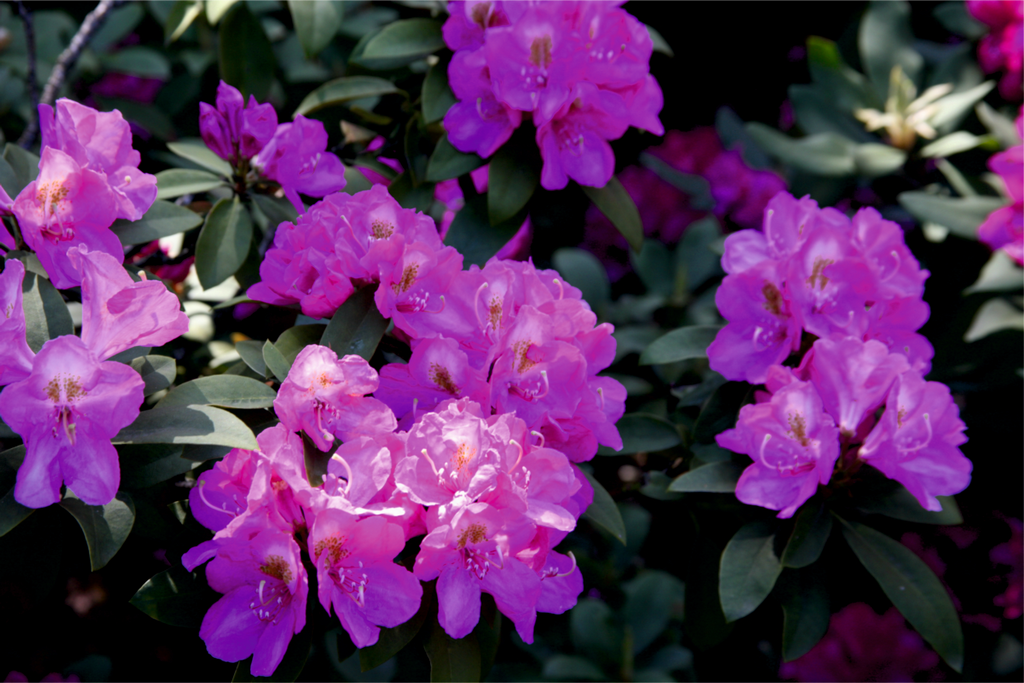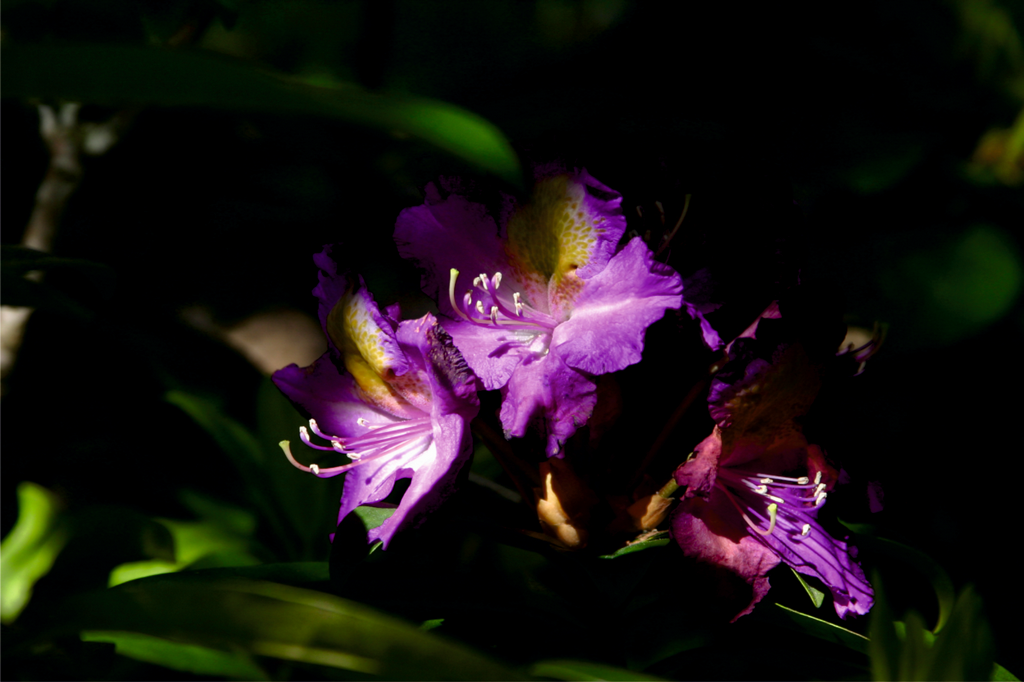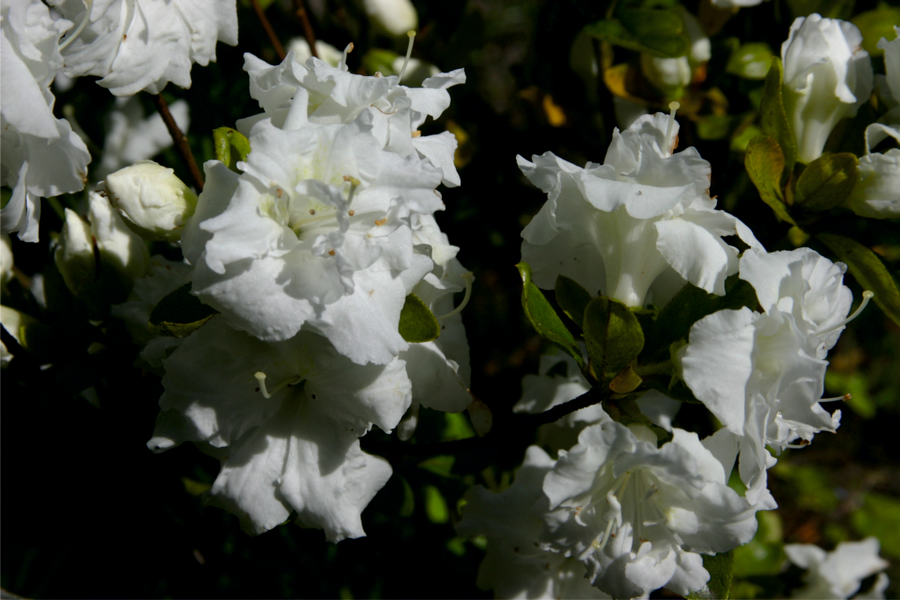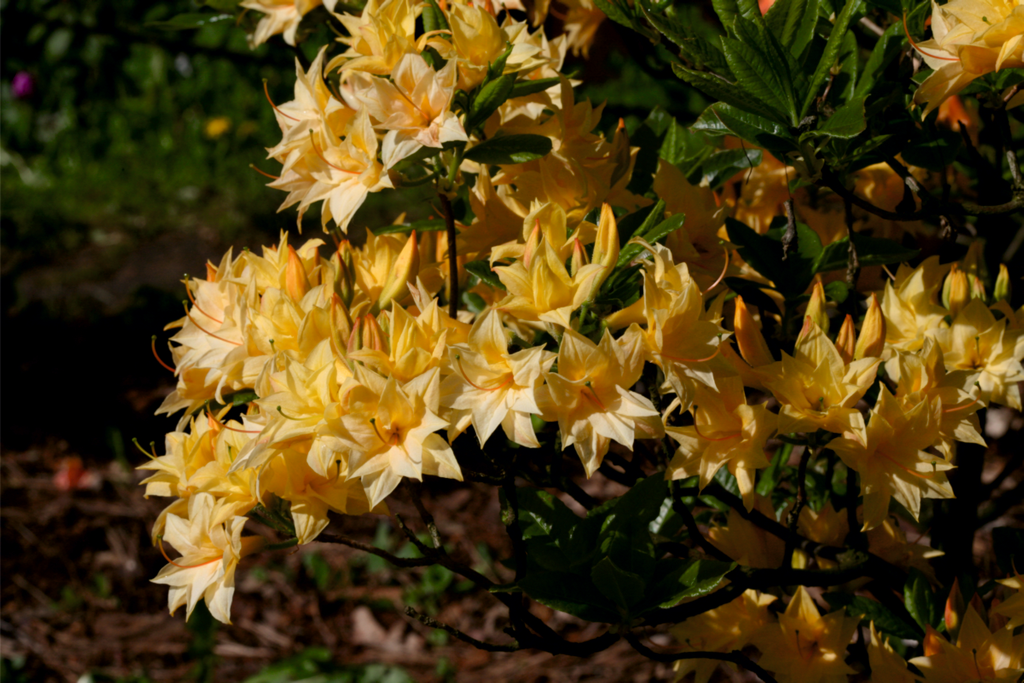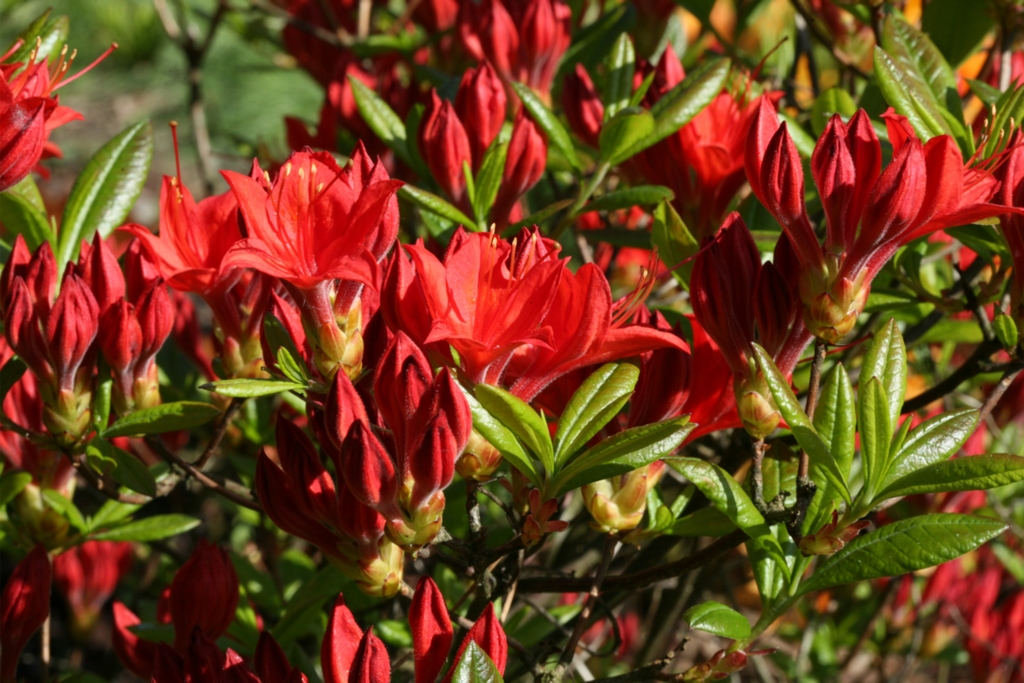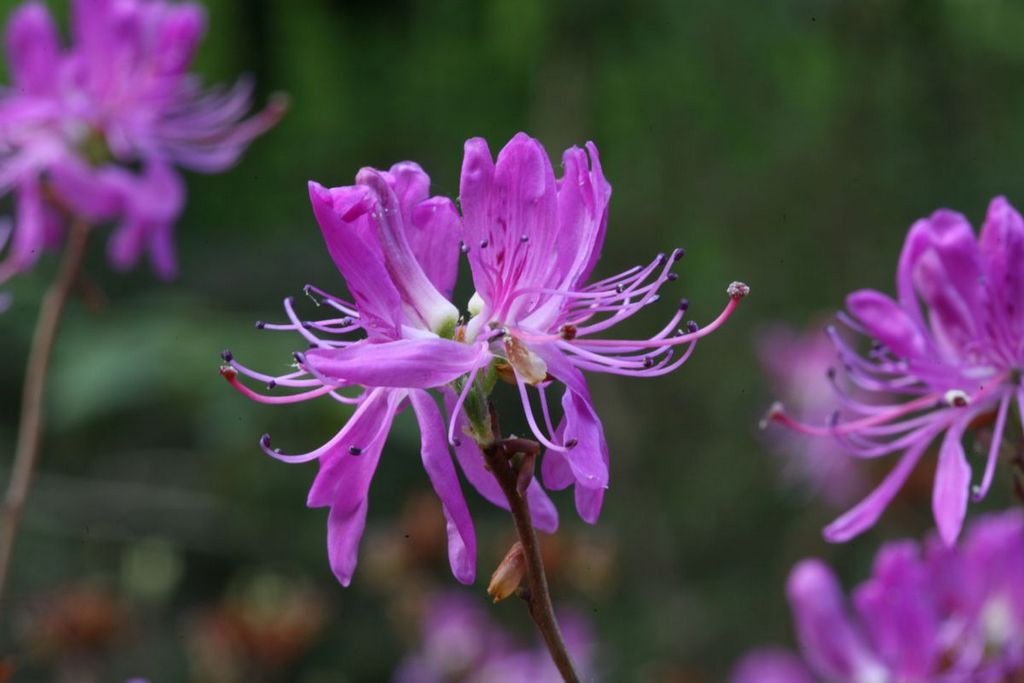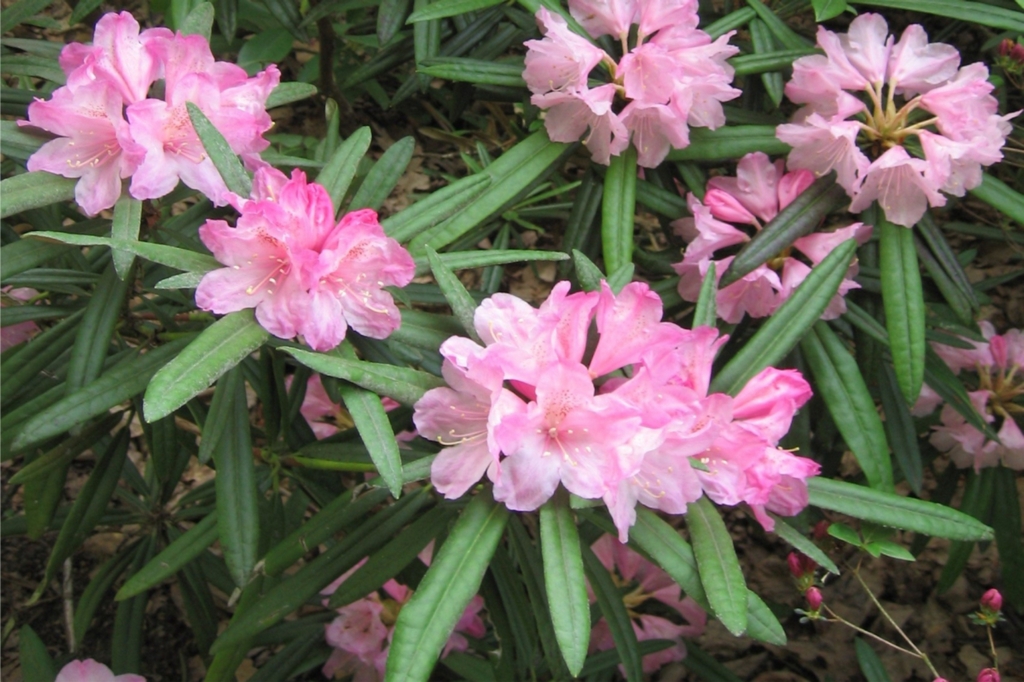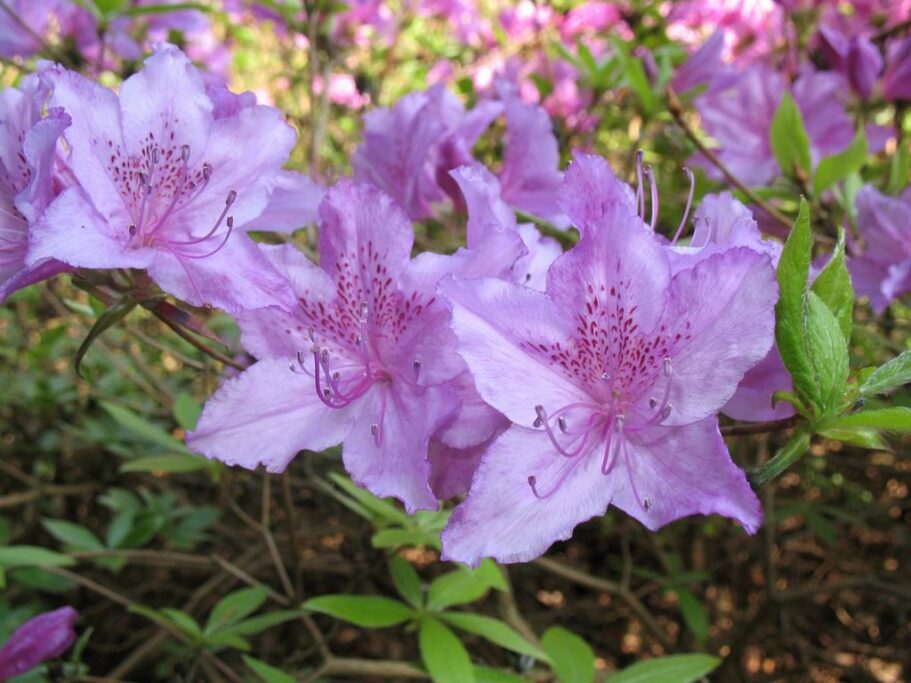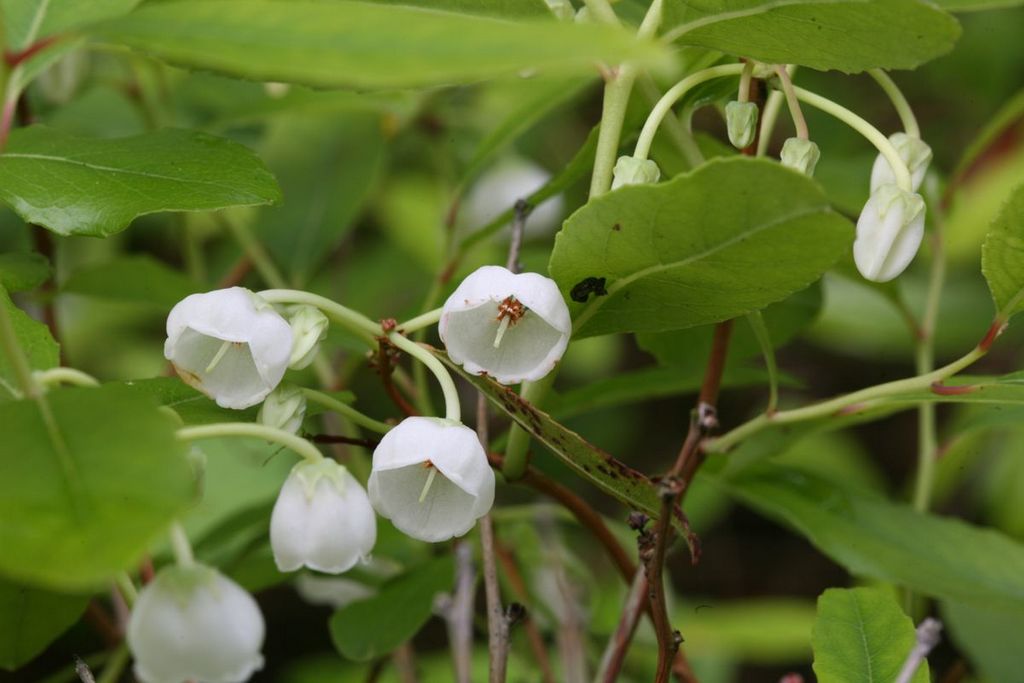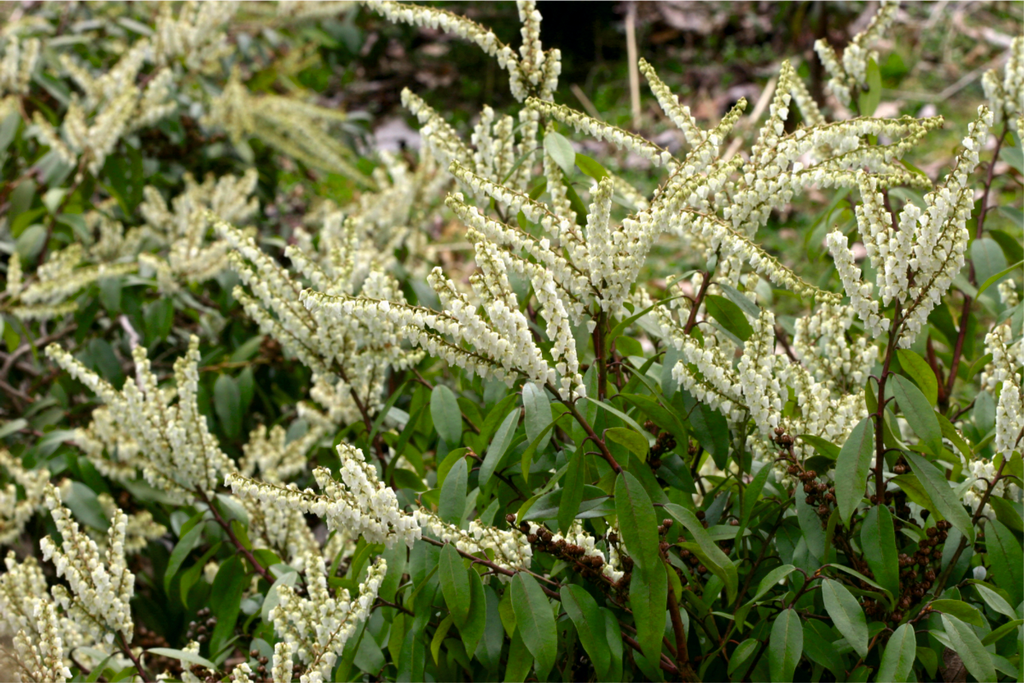Supervisor: Emanuella Szewczyk, M.Sc.
General data: about 600 taxa
Area: 1.6 hectares and numerous enclaves
The collection consists of two main parts Collection of rhododendrons and azaleas and Ericarium and several enclaves in different parts of the botanical garden. The collection consists of 21 botanical genera from the family of Ericaceae - heaths. It is a family that includes plants with adaptations for living in acidic soil or with factors that acidify the environment with a pH of 3.5-6.0. The family has about 4,000 species from all over the world growing on all continents except Antarctica.
In the botanical garden, the largest group of heath plants is the genus Rhododendron - Rhododendron represented by about 400 taxa. You can also admire the genera: larch (Andromeda), bearberry (Arctostaphylos), cobblestone (Bruckenthalia), heather (Calluna), chamedaphne (Chamaedaphne), dabecja (Daboecia), eliotia (Elliottia), enkiant (Enkianthus), heather (Erica), golteria (Gaultheria), kalmia (Kalmia), swamp (Ledum), cluster (Leucothoë), lyonia (Lyonia), menziesia (Menziesia), cranberry (Oxycoccus), sourwood (Oxydendrum), pieris (Pieris), rhododendron (Rhododendron), blueberry (Vaccinium), Zenobia (Zenobia).

Photo 1. collection of rhododendrons and azaleas
Collection of rhododendrons and azaleas
General data: about 400
Area: approximately 1.1 hectares
The collection began to form in the 1980s and 1990s. Initially, varieties were collected in the so-called mother plant in the vicinity of Villa Janówek, where the oldest specimens can be found. Then collections were started in the Arboretum and Oak Avenue. 121 botanical species were collected, 171 varieties of evergreen azaleas and 130 varieties of azaleas.
The genus name is derived from two Greek words rhodon = rose and dendron = a tree with the Polish name azalea. Both evergreen azaleas and azaleas belong to one genus. By the name azalea, we customarily refer to those species and their varieties that do not lose their leaves for the winter, while azaleas refer to those that lose their leaves and are divided into those that bloom before and after leafing out. Recent taxonomic approaches have added to this genus species previously belonging to the genera Ledum - swamp, Rhodothamnus - rhododendron and Menziesia.
One of the species of this genus growing in Poland is the rhododendron yellow (Rhododendron luteum Sweet.) (Photo 2) Also called Pontine azalea. Its large groups can be observed at the northern entrance to the garden. When it blooms in late April and early May, there is a sweetish fragrance in the air, which in Ukraine, where it is more abundant, it is said that this scent can put an entire army regiment to sleep.
Some of the earliest flowering species in the collection include the Dahur azalea (Rhododendron dauricum L.) and his relative Ledebour rhododendron (Rhododendron ledebourii Pojark.) (Photo 3) capable of blooming as early as March. Among the azaleas, the most beautiful flowering ones include. Schlippenbach's rhododendron (Rhododendron schlippenbachii Maxim.) (Photo 4) with large fragrant flowers, and the Albrecht azalea (Rhododendron albrechtii Maxim.) with intensely colored flowers in pink.
Among the more interesting species is the Yakushima rhododendron (Rhododendron degronianum ssp. yakushimanum) a Japanese endemic growing on only one small island, Yakushima, which is the father of cultivated varieties found in gardens. Shrouded in legend is the rhododendron alpine (Rhododendron ferrugineum L.) (Photo 5), which, according to accounts, was said to have saved the life of Count Fritz von Oheimb during one of his Alpine excursions, who has since taken an interest in the genus and established a collection in his garden, which is now the Arboretum in Wojsławice.
Among the evergreen varieties in the collection reigns Rhododendron 'American' (photo 6) With ruby flowers, a large evergreen shrub. Places with this variety can be found in every part of the collection. Beautiful white and large flowers can boast a variety of 'Catawbiense Album' (photo 7). Variety names also include sometimes famous or crowned figures, as well as family members of explorers such as 'Kate Waterer'(photo 8) With beautiful neon pink flowers. Two-color, often contrasting varieties are very popular among gardeners and growers. In the collection, among such varieties we can distinguish the variety 'Tamarindos' (Photo 9) With purple flowers with a large yellow eye on the upper petal.
Azalea varieties gathered along one of the Arboretum's glades every year cause admiration of our guests, beautiful colors, fragrances and juxtapositions draw crowds every year. Beautifully presented is the classic flower form of the variety 'Tucan' (Photo 10) white with a yellow eye, although varieties with full flowers, like the 'Einzprincessin' (photo 11), will also find their fans. The group of Rustica azaleas introduced into cultivation already in the 19th century, with full flowers with pointed petals, is represented by the variety 'Phebe' (photo 12). The rightful name can boast 'Carat' (photo 13) With flowers like ruby ring eyes. The variety is derived from the sticky azalea, which can be found in Ericarium.
Ericarium
General data: about 120 taxa
Area: 0.35 ha
Formerly known as - Collection of little-known heath plants - is a collection of species from the Ericaceae - heath family. The species collected over the years come from North America, Asia and Europe. The collection is located in the eastern part of the Arboretum between the Warsaw Escarpment and one of the numerous ravines. Surrounded by trees and densely overgrown, it creates an interesting seance of light, color, fragrance and texture at any time of the year.
In the collection we can find little known and rarely seen species of rhododendrons (Rhododendron) and valuable garden varieties. Visitors' attention may be drawn to sticky azalea (Rhododendron viscosum Torr.) (Photo 14), with white star-shaped and strongly fragrant flowers, or Canadian azalea (Rhododendron canadense (L.) Torr.) (Photo 15) with charming pink-purple flowers - both are native to North America. Among the representatives of the genus from Asia, look at Makina rhododendron (Rhododendron makinoi Tagg) (Photo 16) with thin and long leaves, the underside of which is covered with a tarnish. The pink pearl is Korean azalea (Rhododendron yedoense var. poukhanense (Lévl.) Nakai) (Photo 17). Its flowering is considered one of the most abundant in azaleas - in May the shrub is covered with a multitude of pink, fragrant flowers.
Representatives of little-known heaths worth a look are American sourwood (Oxydendrum arboretum (L.) DC.) (Photo 18) tree representative in the family Ericaceae With beautiful flowers in the form of panicles that appear during the summer. Zenobia śniada (Zenobia pulverulenta (W. Bartram ex Willd.) Pollard) (Photo 19) - A small shrub with flowers similar to lily of the valley, named after Queen Zenobia of Palmyra. The ornament of the collection during the winter is a laurel cluster (Leucothoë fontanesiana (Steud.) Sleumer) (Photo 20) with evergreen leaves that turn shades of red in the cool season, placed alternately on overhanging stems. Also blooming in spring is bell-shaped enkianthus (Enkianthus campanulatus (Miq.) G.Nicholson) - a shrub from the mountainous regions of Asia with beautifully colored leaves in autumn. In the collection you can see three species of the genus Pieris - Shrubs with evergreen leaves resembling a laurel leaf, and panicles with white bell-shaped flowers - floral breast (Pieris floribunda (Pursh) Benth. & Hook. f.) (Photo 21), Japanese pieris (Pieris japonica (Thunb.) D. Don ex G. Don ) and smooth primrose (Pieris formosa (Wall.) D. Don). An interesting feature is the shining elliot (Elliottia bracteata Benth. & Hook) - A small plant with white flowers with pink blush, blooming in summer, hidden in the collection.
Photo authors:
Wieslaw Gawrys
Alina Kaczkowska
Agnieszka Kosciellak


